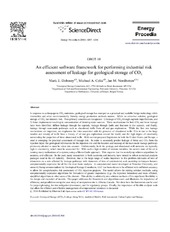| dc.description.abstract | In response to anthropogenic CO2 emissions, geological storage has emerged as a practical and scalable bridge technology while renewables and other environmentally friendly energy production methods mature. While an attractive solution, geological storage of CO2 has inherent risk. Two primary concerns are recognized: (1) leakage of CO2 through caprock imperfections, and (2) brine displacement resulting in contamination of drinking water sources. Three mechanisms for both CO2 and brine leakage have been identified: diffuse leakage through the caprock, leakage through faults and fractures in the caprock, and finally, leakage through man-made pathways such as abandoned wells from oil and gas exploration. While the first two leakage mechanisms are important, we emphasize the risks associated with the presence of abandoned wells. This is due to the large number and density of wells from a history of oil and gas exploration around the world, and the high degree of uncertainty surrounding the properties of these abandoned wells. With current proposed legislation in both the United States and Europe, a need is emerging for practical assessment of leakage risk. In order to accurately predict leakage of brine and CO2 from the injection layer, the geological information for the injection site and the location and makeup of the man-made leakage pathways previously alluded to must be taken into account. Unfortunately, both the geology and abandoned well metadata are typically high in uncertainty, which must be accounted for. With such a high number of random variables, the current state of the art is running many realizations of a system, using a Monte Carlo approach. This requires that the underlying solution algorithms be accurate, and efficient. In the past, many researchers in both academia and industry have turned to robust numerical analysis packages used in the oil industry. However, due to the large range of scales important to this problem (domains of tens of kilometers on a side affected by leakage pathways with diameters of tens of centimeters) such modeling techniques become computationally expensive for all but the most basic analysis. A computational model developed at Princeton University, and currently being commercialized by Geological Storage Consultants, LLC has been shown to be efficient with sufficient accuracy to allow for comprehensive risk assessment of CO2 injection projects. The model allows for mixing solution methods- using computationally expensive algorithms for formations of greater importance (e.g.- the injection formation) and more efficient, simplified algorithms in other areas of the domain. This ability to arbitrarily mix solution methods offers significant flexibility in the design and execution of models. This paper addresses the framework and algorithms used, and illustrates the importance of efficiency and parallelism using the case study of an injection site in Alberta, Canada. We show how the framework can be used for project planning, for risk mitigation (insurance), and for regulatory groups. Finally, the importance of flexible analysis tools that allow for efficient and effective management of computational resources is discussed. | en_US |

